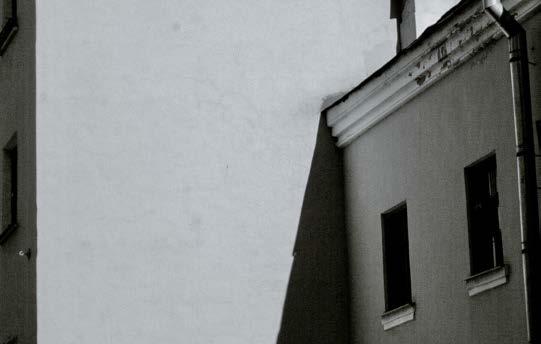
8 minute read
The Guilty and Suspenseful Sound
Written by Robyn Bacon
The Danish film The Guilty (2018) masterfully builds suspense by taking away one primary sense commonly associated with film—sight. The film takes place over the course of one night after the protagonist—a policeman named Asger gets assigned to emergency dispatch operator duty. As his shift nears to an end Asger receives a call from a woman named Iben who has been abducted. While Asger is only able to help Iben through his telephone headset device he begins working overtime and against company policy in order to secure Iben’s safety. The film effectively builds suspense using diegetic offscreen sound instead of crosscutting. Diegetic offscreen sound is sound that has a source in the story world. This includes words spoken by characters, sounds from objects in the story, and music implied to be from instruments in the story space (Bordwell and Thompson 284). In regard to offscreen diegetic sound, the sound still exists in the story world, but the source of the sound exists and functions outside the camera frame (Bordwell and Thompson 285). Alternatively, crosscutting is an editing technique that cuts back and forth between two different characters situated in two different locations where the action is occurring at the same moment in time. Commonly used in the thriller genre—crosscutting gives strong visual continuity and provides the audience with unrestricted knowledge of story information.
Advertisement
In The Guilty when Asger and Iben speak over the phone the film restricts the audience from receiving visual story information, and instead gives story information to the audience only through diegetic offscreen sound. This makes it uncertain for the audience to understand where Iben is and what she is doing. The audience relies on diegetic offscreen sound that can only imply what Iben is doing physically. In this way, the audience and Asger are learning new story information at the same time—which produces a unique and intensified approach to the creation of suspense. Usually in the thriller genre suspense is created when the audience knows more story information than the protagonist. This story information—usually delivered by crosscutting—is instead supplied by diegetic offscreen sound. Diegetic offscreen sound weakens the linear sense of cause and effect and temporal simultaneity in the film. In turn, this skewers visual expectations and strengthens suspense. Instead of simply seeing cause and effect and temporality on screen, the audience must listen for it. This can trick the audience to doubt their ability to gain accurate story information. After all, seeing is believing but in the case of The Guilty, listening must suffice.

The Strength of Diegetic Offscreen Sound
In The Guilty diegetic offscreen sound contributes vital information to the story in creative way while sustaining suspense. In the film it does this through question-and-answer dialogue. Asger asks Iben questions and Iben answers them—which creates a productive back-and-forth dynamic between characters. However, this back-and-forth is made more difficult when Asger learns that Iben is with her kidnapper, and can only answer yes or no questions, otherwise the kidnapper will discover that Iben is speaking with emergency services which could endanger Iben’s life further. Instead, Asger tells Iben to pretend that she is talking with her young daughter over the phone, and to answer his questions by replying yes or no. The diegetic off-screen sound that Asger hears while talking to Iben on his phone also manifests itself as subjective diegetic off-screen sound. Subjective diegetic off-screen sound gives the audience perceptual subjectivity from Asger’s auditory perspective while blocking the audience from locating the physical source of the sounds that Iben is experiencing off-screen. The technique of off-screen sound plays with ideas of sound perspective, which refers to the spatial distance and location determined by visual depth cues and volume level (Bordwell and Thompson 292).
The Guilty forces the audience to listen to the changing volume levels of Iben’s voice and actions. If Iben’s voice sounds loud on her cell phone it appears to seem near; if her voice sounds soft, she is further away. In The Guilty, loudness of volume indicates that Iben is on her cell phone and speaking directly with Asger. Softness of volume implies that Iben may soon hang up, loose cell phone connection with Asger, or has put the phone aside in order to perform a physical action—or turn it off completely. For example, when Asger realizes that Iben’s kidnapper is listening to her phone calls Asger begins to ask Iben a series of yes or no questions that will help him learn more information about her location. Asger asks: “Do you know the person you’re with? Does he have a weapon? Have you been abducted? Are you on a motorway? South towards Copenhagen? North?” (Gustav Möller, 2018). Iben proceeds to answer these questions and her voice is loud and shaky on the phone, which also gives auditory clues that suggest that the kidnapper is listening in close proximity to Iben’s conversation. After Iben answers Asger’s questions it allows Asger to discern where Iben might be without putting her in immediate danger. These auditory clues help can help the audience piece together fragmented story information by listening to the characteristics of diegetic off-screen. These characteristics include: rhythm, volume, timbre, and pitch of their words and breathing patterns. Based on this auditory evidence the audience can make an educated guess at the motivations and actions that a character will divulge or execute next.

Seeing is Believing: Guilt & Trauma
Themes of trauma, loneliness and guilt motivate both Asger and Iben’s internal conflict. While Asger has a moral obligation to locate Iben and bring her safely home his psychological need to save Iben stems from a place of guilt. Near the end of the film, Asger discovers that Iben is mentally ill and is responsible for murdering her son Oliver in an attempt to cleanse the evil out of his spirit. After Iben realizes the devastating crime she committed the feeling of guilt begins to overwhelm her and she contemplates ending her life. While Iben’s life hangs in the balance, Asger panics and confesses to Iben that while on duty as a policeman he purposefully shot and killed a nineteen-year-old teenage boy named Josef who would have otherwise gotten away with committing a crime. Asger tells Iben that he is planning to lie in court that he shot Josef in selfdefense, when truthfully, he simply did not want Josef to get away. In reality, Asger made a reckless and impulsive decision to cleanse the “bad” out of the world by shooting Josef—and his overwhelming guilt is the price he pays for it. After these confessions are made clear in the film, the grand theme of guilt comes to fruition. The audience discovers that Asger and Iben share a similar objective—to make the world a better place by cleansing the bad out of it. Ultimately, their actions had devastating effects.
After Iben listens to Asger’s confession she thanks Asger for everything he has done to help her during his shift and promptly hangs up the phone. When the calls disconnects Asger is devastated. He frantically tries calling Iben back multiple times— the empty rings leading Asger to her voicemail. When Asger calls the dispatch he sent to find Iben, they report that they have Iben in their custody. “Yes, we have her. Good job Asger” (Möller, 2018) and Asger is relieved. Without the help of diegtic offscreen sound, Asger would not have known how to properly talk Iben down from the bridge had he not been actively listening to the volume, timbre, and sound perspective of Iben’s words and background noises of her unknown location. These sounds helped Asger understand what Iben was going to do next, and where she was so that he could send emergency services to rescue her and save her life. The Guilty reveals that Iben and Asger both struggle with mental illness and that guilt and trauma are what emotionally binds them together over the course of one night. The filmic elements of sound and dialogue that The Guilty rely on provide exposition for characters without spoiling an excess of story information which effectively sustain suspense. The Guilty skilfully denies the audience the visual continuity that crosscutting supplements and instead employs diegetic off-screen sound to intensify suspense. The Guilty constructs suspense by delivering restricted story information using characteristics of sound that include: rhythm, timbre, pitch, volume level, and sound perspective.
Works Cited & Works Consulted
The Guilty. Directed by Gustav Möller. Det Danske Filminstitut, 2018.
Bordwell, David, and Kristin Thompson. Film Art: An Introduction. Boston: McGraw-Hill, 2013. Print.
Buder, Emily. “‘The Guilty’: The Pulse-Pounding Crime Thriller Set on One Side of a Phone Call.” No Film School, https:// nofilmschool.com/2018/12/sundance-the-guilty-gustav-moller-magnolia. Accessed 30 December 2020.










